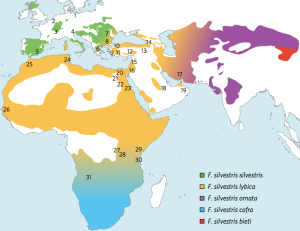“In its simplest form, to domesticate an animal means to tame it, through breeding and training, to need and accept the care of humans.” (Ault, 2015). By this definition, humans have been domesticating dogs for roughly 30,000 years, ever since they diverged from their wolf ancestors and came to rely on their human masters for food, shelter, and companionship (Ault, 2015). Other mammals that are commonly kept as pets or livestock have similar histories of being controlled and selectively bred by humans, with one notable exception. When it comes to cats, the question is not how long they have been domesticated, but whether they have ever truly been domesticated at all.
In 2017, an international team of scientists led by University of Leuven geneticist Claudio Ottoni published the results of a project in which they analyzed the mitochondrial DNA of over 200 cats whose dates ranged from about 9,000 years ago to the present (Newitz, 2017). The team identified two major waves of domestication that contributed to the role of cats in human society today. The first took place in the Fertile Crescent roughly 7,500 years ago, when wildcats from Anatolia started hanging around human settlements due to the presence of mice and rodents (Ottoni, 2017). In a way, these cats domesticated themselves by inadvertently building a symbiotic relationship with humans in farming communities: humans’ crops attracted rodents, and it was beneficial to both parties if cats ate those rodents (Tufts, 2017). By the time of the Mediterranean “classical era,” most ships’ captains kept a cat onboard in order to take care of vermin, which allowed these wildcats to spread along shipping routes (Figure 1) (Newitz, 2017).
The second major wave of domestication occurred during the Greek and Roman periods, when the popularity of Egyptian cats led to a massive migration of cats descended from the North African F. s. lybica to Europe. These Egyptian cats spread as far north as the Baltic Sea and as far east as Iran by the 8th century AD, which significantly increased the presence of f. s. lybica in the overall house cat gene pool (Ottoni, 2017).

Figure 2. A blotched tabby, possibly the first human-created cat breed. Photograph by Vladislav Starozhilov.
Ottoni’s research team did not find evidence of humans breeding cats until the Middle Ages, when the human-created “blotched tabby” (Figure 2) emerged. Compared to domestic dogs, who have been more or less completely controlled by humans for many millennia, humans have been breeding cats for less than 1,000 years (Newitz, 2017). Furthermore, since cats have not been bred as selectively as dogs, they have been able to retain their hunting skills in a way that dogs and other domestic animals have not. In fact, the genes of felis catus (the average housecat) and felis silvestris (the European wildcat) are nearly identical (Ault, 2015). With this information in mind, is it appropriate to call a house cat “domestic” if it is still capable of surviving in the wild on its own?
Additional Reading:
On the cultural history of house cats: https://www.smithsonianmag.com/history/a-brief-history-of-house-cats-158390681/
On the domestication of many species of pets and livestock: https://www.jyi.org/2012-february/2017/9/17/our-furry-friends-the-history-of-animal-domestication
References:
Ault, Alicia.
April 30, 2015 Ask Smithsonian: Are Cats Domesticated? Smithsonian.com. https://www.smithsonianmag.com/smithsonian-institution/ask-smithsonian-are-cats-domesticated-180955111/, accessed November 3, 2019.
Newitz, Annalee.
June 19, 2017 Cats are an extreme outlier among domestic animals. Ars Technica. https://arstechnica.com/science/2017/06/cats-are-an-extreme-outlier-among-domestic-animals/, accessed November 3, 2019.
Ottoni, C.; Neer, W. V.; Cupere, B. D.; Daligault, J.; Guimaraes, S.; Peters, J.; Spassov, N.; Prendergast, M. E.; Boivin, N. L.; Morales-Muñiz, A. et al.
June 19. 2017 The Complex Domestication of Cats. Max Planck Institute for the Science of Human History. https://www.shh.mpg.de/446464/cat-adna, accessed November 3, 2019.
Tufts Catnip.
August 2017 The Domestication of Cats. Cummings School of Veterinary Medicine at Tufts University. http://www.tuftscatnip.com/issues/25_8/feature/The-Domestication-of-Cats-824-1.html, accessed November 3, 2019.


Interesting post!! This is the first time I have read about cats through an Anthropologic lens. It makes me wonder, how can studying non-human species help us to better understand humans? What are the benefits of multi-species approaches?
I think that studying non-human species can be incredibly useful for helping us better understand humans because human history is intrinsically linked with the history of plants and animals. According to Piers Locke and Ursula Muenster, “Multispecies ethnography however, not only acknowledges that humans dwell in a world necessarily comprising other life forms but also contends that their entanglements with human lives, landscapes, and technologies must be theoretically integrated into any account of existence” (Locke, 2015). Locke and Muenster suggest that it may be impossible to create any type of account of human existence without considering the contributions and influences of other life forms. This rings especially true when it comes to livestock and work animals, which have had significant impacts on the histories of human technology, agricultural development, and even politics. However, the same goes for domestic animals such as cats; just as humans have had an impact on the history of cats (through breeding and domestication), cats have had a profound impact on the history of humans. This interconnectedness is evident in things as mundane as keeping a cat on a ship to eat rodents, as well as in more culturally significant concepts such as cat-based deities.
Works Cited:
Locke, Piers and Ursula Muenster.
November 30, 2015 Multispiecies Ethnography. Oxford Bibliographies. https://www.oxfordbibliographies.com/view/document/obo-9780199766567/obo-9780199766567-0130.xml, accessed November 14, 2019.